Binary Newton Calculation Method of Residual Stress Based on the Indentation Energy Difference Theory
Abstract
:1. Introduction
2. Residual Stress Calculation Model Design Based on the Newton Method
3. Derivation of the Newton Formula for Binary Equation
4. Results and discussion
4.1. Analysis of Newton Fitting Effect of Indentation Data
4.2. Measurement and Analysis of Biaxial Residual Stress
5. Conclusions
Author Contributions
Funding
Institutional Review Board Statement
Informed Consent Statement
Data Availability Statement
Conflicts of Interest
Nomenclature
| Indentation energy coefficient | Elasticity coefficient | ||
| Fit Deviation | Volume of Knoop indenter intruded into the specimen | ||
| Load | φ | Knoop indenter direction coefficient | |
| Depth | Indentation energy difference under uniaxial stress perpendicular to the long axis of the indenter | ||
| Indentation work | Material-related plasticity coefficient | ||
| Sum of all data fit standard deviations | Indentation energy difference. i, j are the indenter direction and stress direction, respectively | ||
| Indentation energy difference in one direction | Indentation work in a certain direction | ||
| Three coefficients of a quadratic function of one variable | Parameters associated with parameters u and F. i and j are the powers of u and F, respectively | ||
| The nonlinear function constructed in the process of solving C | The nonlinear function constructed in the process of solving C |
References
- Huchings, M.T.; Withers, P.J.; Holden, T.M.; Lorentzen, T. Introduction to the characterization of residual stress by neutron diffraction. Exp. Dermatol. 2005, 13, 505–511. [Google Scholar] [CrossRef]
- Peng, W.; Jiang, W.; Jin, Q.; Wan, Y.; Luo, Y.; Ren, L.; Zhang, K.; Tu, S.-T. Reduction of welding residual stress in the head-cylinder joint of a large rectifying tower by finite element method and experimental study. Int. J. Press. Vessel. Pip. 2021, 191, 104311. [Google Scholar] [CrossRef]
- Yan, S.; Meng, Z.; Chen, B.; Tan, C.; Song, X.; Wang, G. Prediction of temperature field and residual stress of oscillation laser welding of 316LN stainless steel. Opt. Laser Technol. 2022, 145, 107493. [Google Scholar] [CrossRef]
- Huang, X.-D.; Zhang, X.-M.; Ding, H. A novel relaxation-free analytical method for prediction of residual stress induced by mechanical load during orthogonal machining. Int. J. Mech. Sci. 2016, 115–116, 299–309. [Google Scholar] [CrossRef]
- Liu, J.; Yuan, H. Prediction of residual stress relaxations in shot-peened specimens and its application for the rotor disc assessment. Mater. Sci. Eng. A 2010, 527, 6690–6698. [Google Scholar] [CrossRef]
- Marshall, D.B.; Lawn, B.R. Residual stress effects in sharp contact cracking. J. Mater. Sci. 1979, 14, 2001–2012. [Google Scholar] [CrossRef]
- Bolshakov, A.; Oliver, W.C.; Pharr, G.M. Influences of stress on the measurement of mechanical properties using nanoindentation: Part II. Finite element simulations. J. Mater. Res. 1996, 11, 760–768. [Google Scholar] [CrossRef]
- Suresh, S.; Giannakopoulos, A.E. A new method for estimating residual stresses by instrumented sharp indentation. Acta Mater. 1998, 46, 5755–5767. [Google Scholar] [CrossRef]
- Peng, W.; Jiang, W.; Sun, G.; Yang, B.; Shao, X.; Tu, S.-T. Biaxial residual stress measurement by indentation energy difference method: Theoretical and experimental study. Int. J. Press. Vessel. Pip. 2022, 195, 104573. [Google Scholar] [CrossRef]
- Phani, P.S.; Oliver, W.C.; Pharr, G.M. Influences of elasticity on the measurement of power law creep parameters by nanoindentation. J. Mech. Phys. Solids 2021, 154, 104527. [Google Scholar] [CrossRef]
- Li, W.; Huang, C.; Yu, M.; Liao, H. Investigation on mechanical property of annealed copper particles and cold sprayed copper coating by a micro-indentation testing. Mater. Des. 2013, 46, 219–226. [Google Scholar] [CrossRef]
- Crisfield, M.A. A faster modified newton-raphson iteration. Comput. Methods Appl. Mech. Eng. 1979, 20, 267–278. [Google Scholar] [CrossRef]
- Marshall, D.B.; Noma, T.; Evans, A.G. A simple method for determining elastic-modulus–to-hardness ratios using Knoop indentation measurements. J. Am. Ceram. Soc. 1982, 65, c175–c176. [Google Scholar] [CrossRef]
- Momani, S.; Abuasad, S. Application of He’s variational iteration method to Helmholtz equation. Chaos Solitons Fractals 2006, 27, 1119–1123. [Google Scholar] [CrossRef]
- Kang, S.K.; Kim, J.Y.; Park, C.P.; Kim, H.U.; Kwon, D. Conventional Vickers and true instrumented indentation hardness determined by instrumented indentation tests. J. Mater. Res. 2010, 25, 337–343. [Google Scholar] [CrossRef]
- He, A.; Liang, Y.; Zhao, O. Flexural buckling behaviour and resistances of circular high strength concrete-filled stainless steel tube columns. Eng. Struct. 2020, 219, 110893. [Google Scholar] [CrossRef]
- Saadatfard, H.; Niknejad, A.; Liaghat, G.; Hatami, S. A novel general theory for bending and plastic hinge line phenomena in indentation and flattening processes. Thin-Walled Struct. 2019, 136, 150–161. [Google Scholar] [CrossRef]
- Moharrami, R.; Sanayei, M. Improvement of indentation technique for measuring general biaxial residual stresses in austenitic steels. Precis. Eng. 2020, 64, 220–227. [Google Scholar] [CrossRef]
- Deng, D. FEM prediction of welding residual stress and distortion in carbon steel considering phase transformation effects. Mater. Des. 2009, 30, 359–366. [Google Scholar] [CrossRef]
- Dean Deng, H.M. Prediction of welding residual stress in multi-pass butt-welded modified 9Cr–1Mo steel pipe considering phase transformation effects. Comput. Mater. Sci. 2006, 37, 209–219. [Google Scholar] [CrossRef]
- Lee, J.H.; Lee, H.; Hyun, H.C.; Kim, M. Numerical approaches and experimental verification of the conical indentation techniques for residual stress evaluation. J. Mater. Res. 2010, 25, 2212–2223. [Google Scholar] [CrossRef]
- Larsson, P.-L. On the determination of biaxial residual stress fields from global indentation quantities. Tribol. Lett. 2014, 54, 89–97. [Google Scholar] [CrossRef]
- Lee, Y.-H.; Kwon, D. Estimation of biaxial surface stress by instrumented indentation with sharp indenters. Acta Mater. 2004, 52, 1555–1563. [Google Scholar] [CrossRef]
- Kim, Y.-C.; Choi, M.-J.; Kwon, D.; Kim, J.-Y. Estimation of principal directions of Bi-axial residual stress using instrumented Knoop indentation testing. Met. Mater. Int. 2015, 21, 850–856. [Google Scholar] [CrossRef]
- Peng, G.; Xu, F.; Chen, J.; Wang, H.; Hu, J.; Zhang, T. Evaluation of non-equibiaxial residual stresses in metallic materials via instrumented spherical indentation. Metals 2020, 10, 440. [Google Scholar] [CrossRef]
- Zhang, T.; Cheng, W.; Peng, G.; Ma, Y.; Jiang, W.; Hu, J.; Chen, H. Numerical investigation of spherical indentation on elastic-power-law strain-hardening solids with non-equibiaxial residual stresses. MRS Commun. 2019, 9, 360–369. [Google Scholar] [CrossRef]
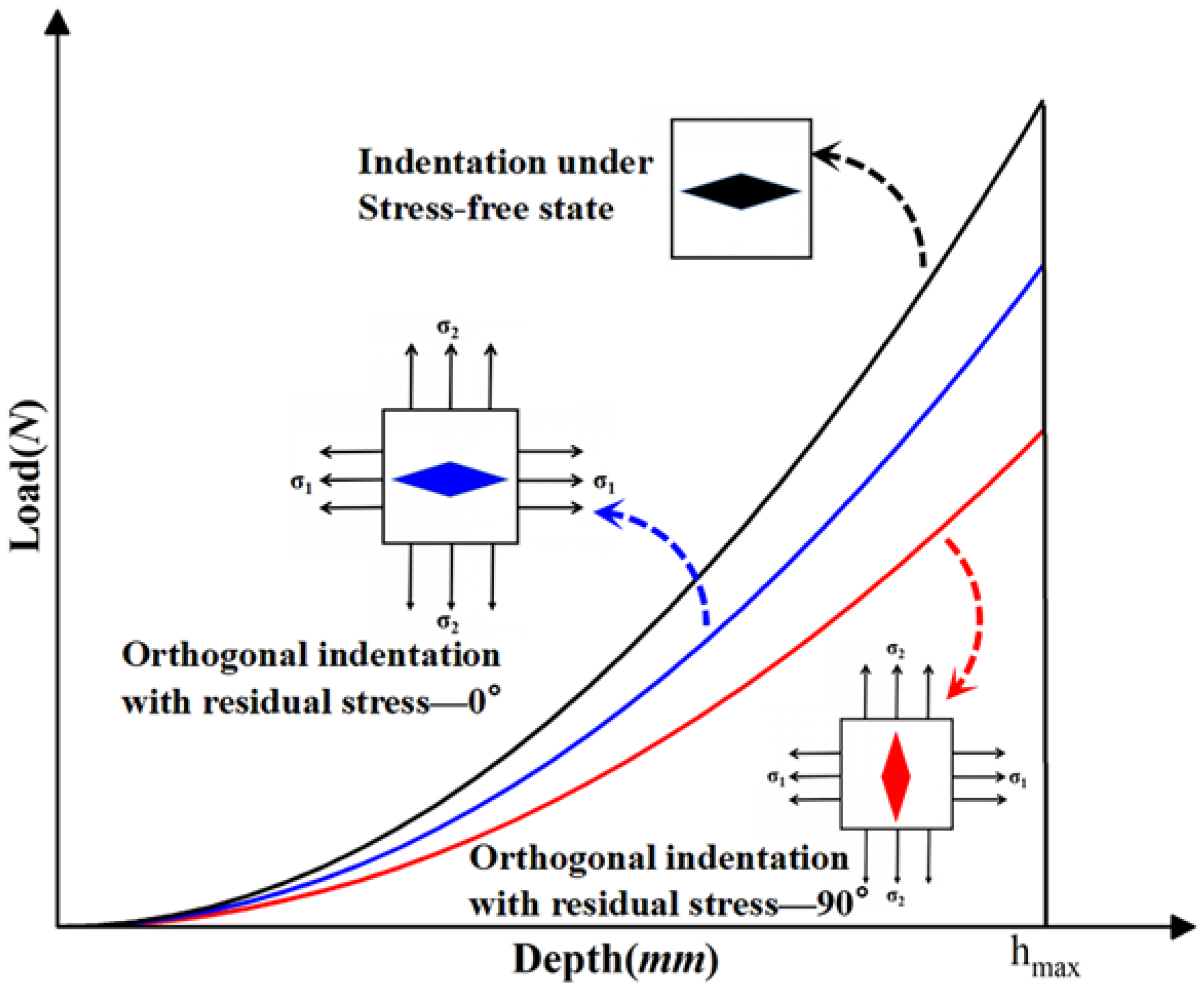
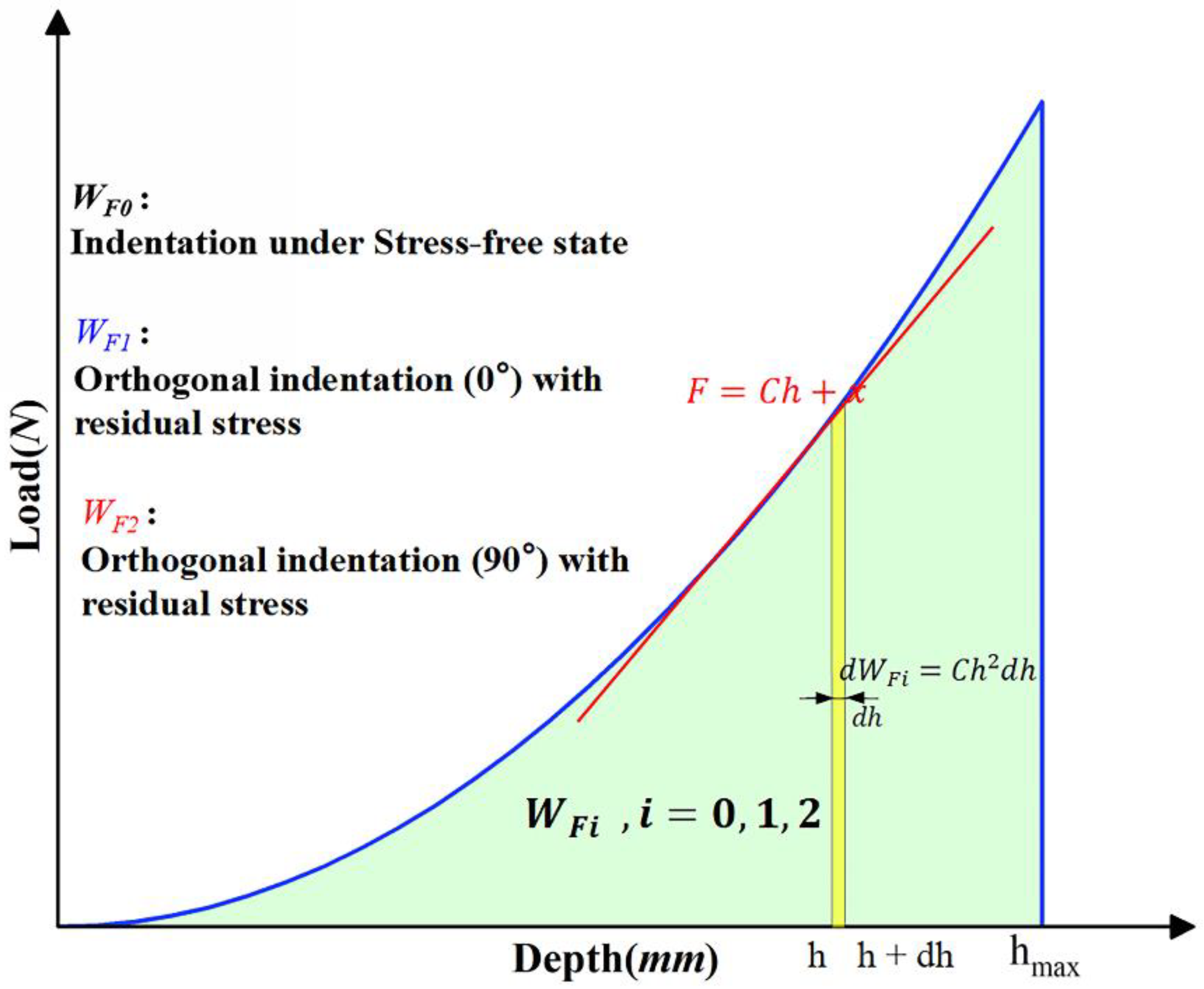
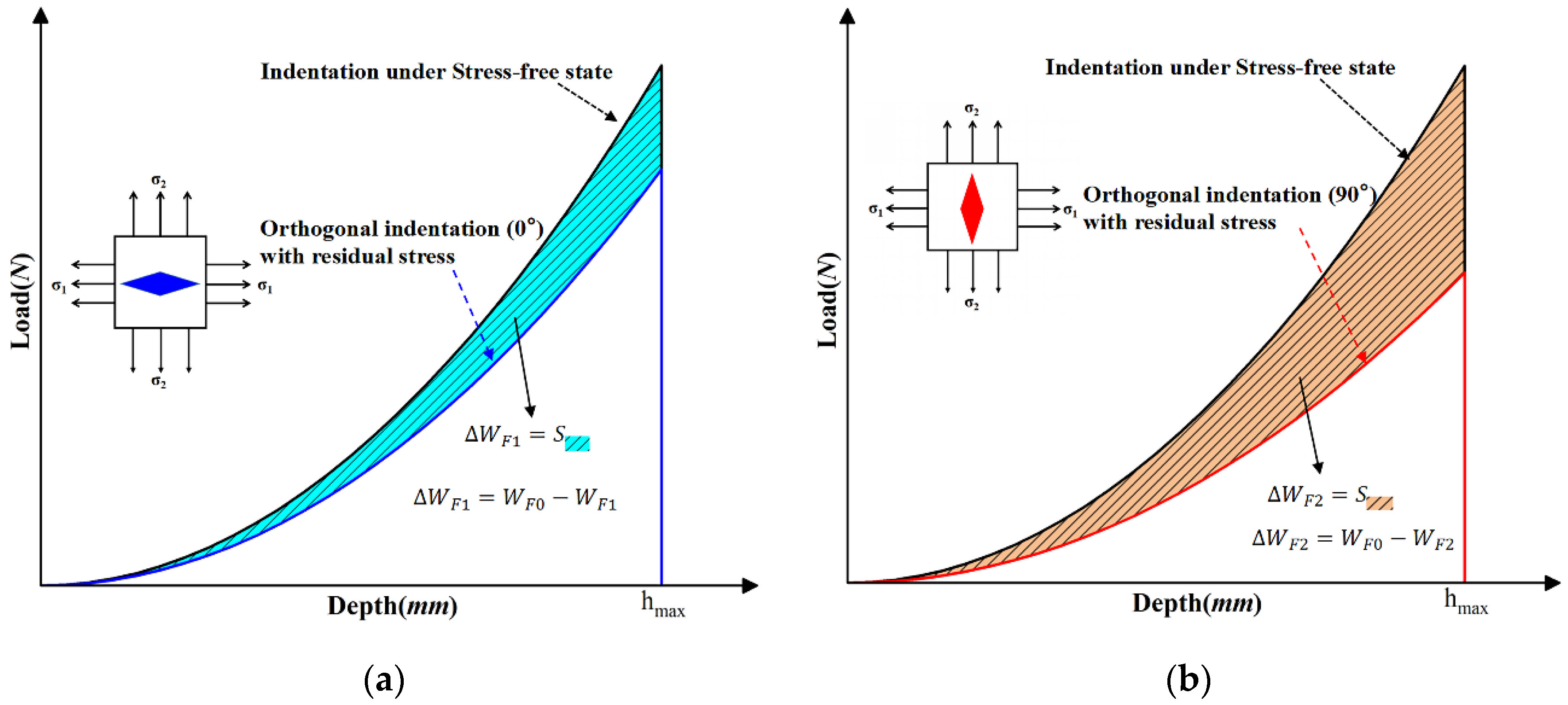
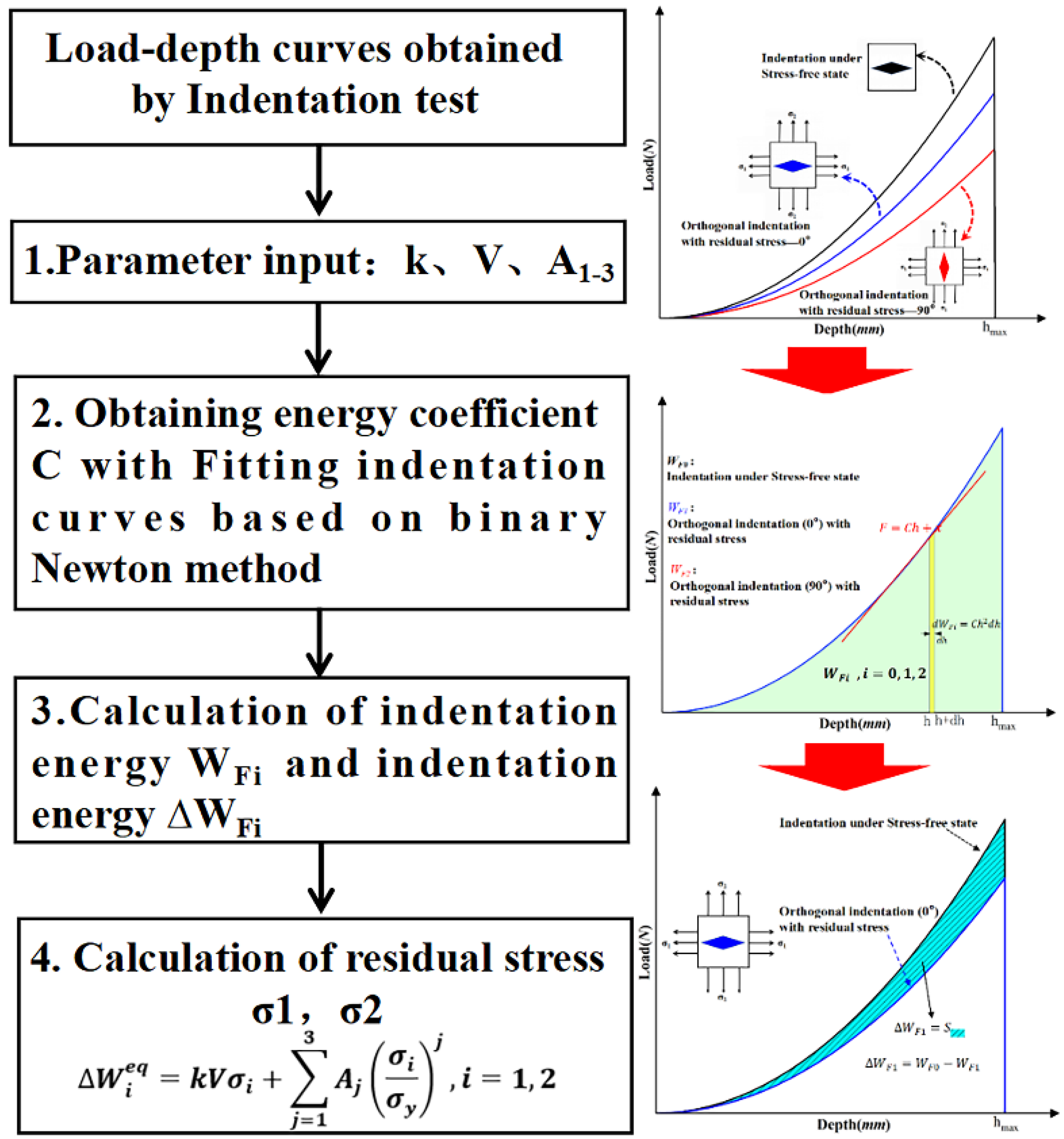
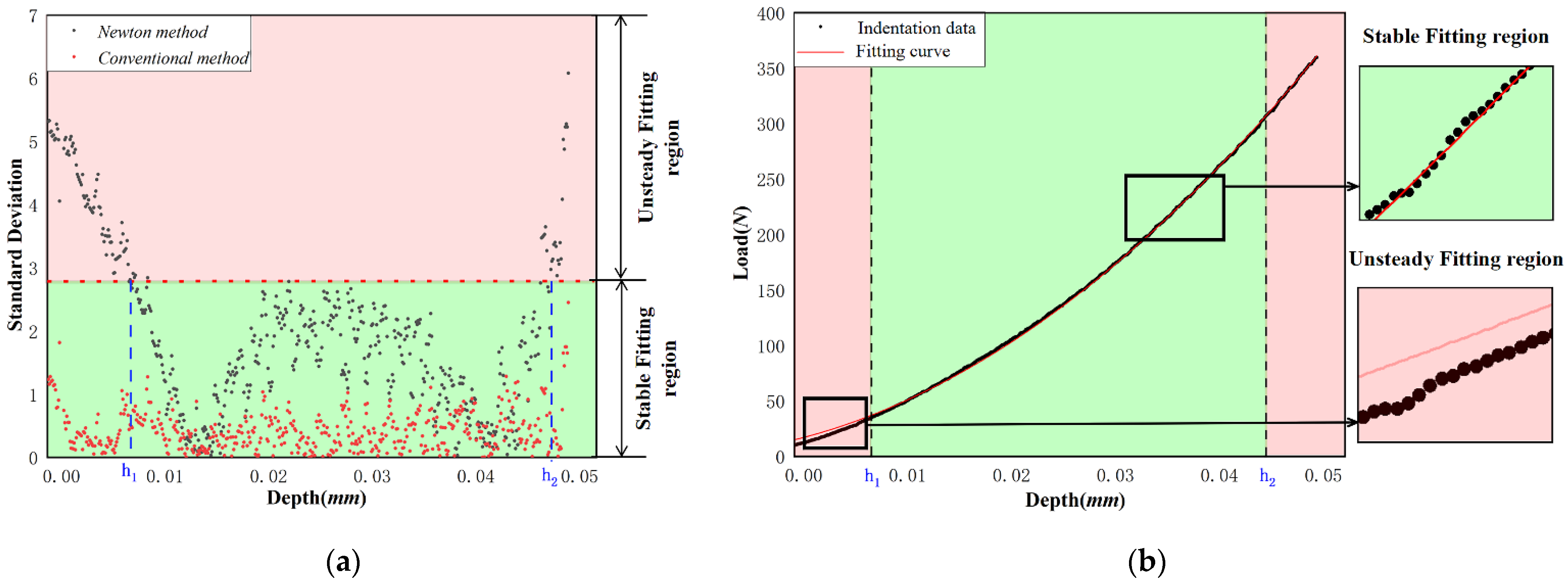
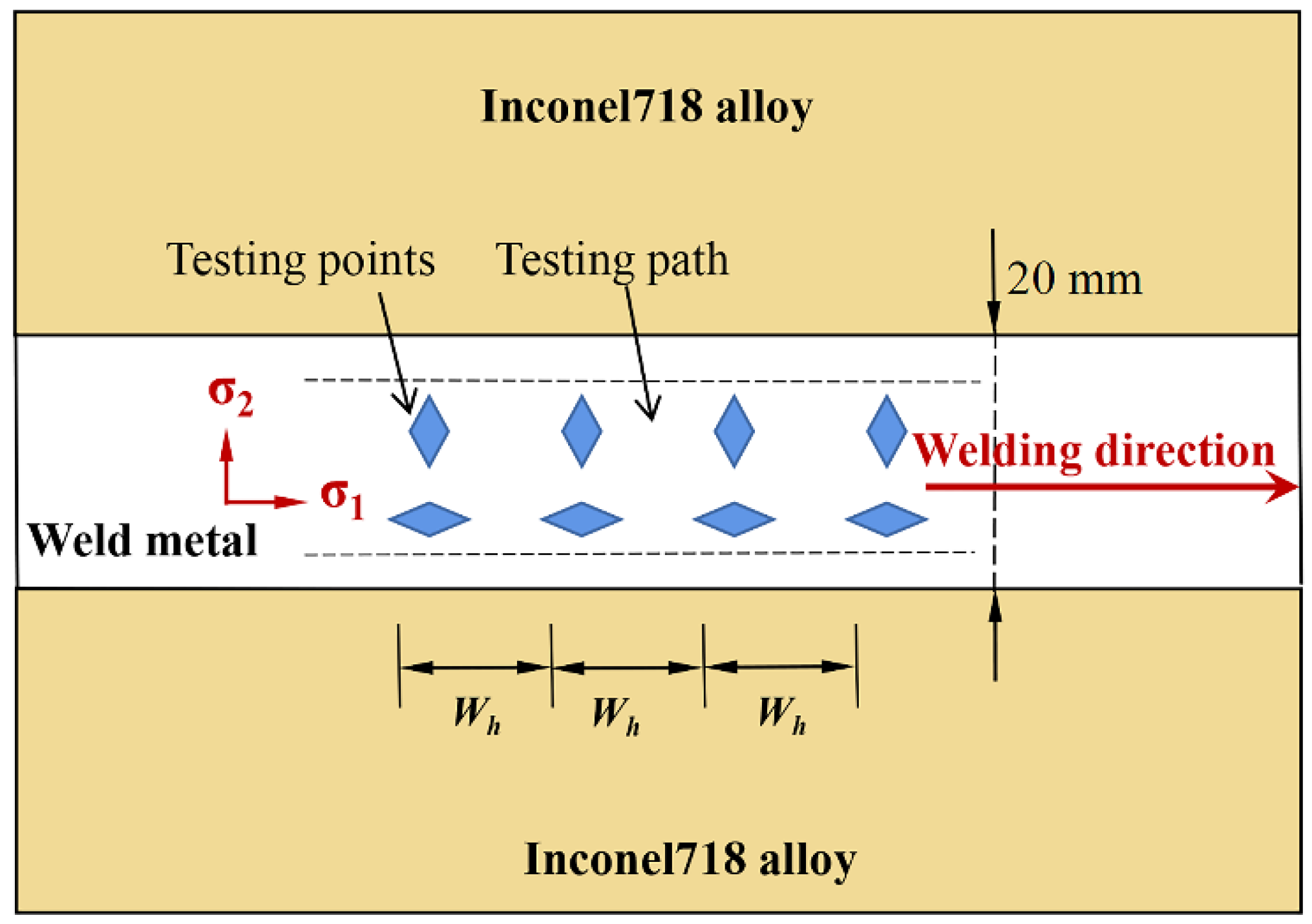

| Standard Value | 1 | 2 | 3 | 4 | 5 | 6 | 7 | 8 | 9 | 10 | |
|---|---|---|---|---|---|---|---|---|---|---|---|
| Newton method | 75,000 ± 5000 | 73,765 | 73,037 | 78,771 | 72,175 | 78,049 | 77,507 | 79,446 | 75,198 | 73,727 | 72,405 |
| Conventional method | 68,195 | 65,268 | 70,139 | 65,398 | 63,502 | 72,918 | 75,668 | 65,640 | 62,379 | 62,375 |
Publisher’s Note: MDPI stays neutral with regard to jurisdictional claims in published maps and institutional affiliations. |
© 2022 by the authors. Licensee MDPI, Basel, Switzerland. This article is an open access article distributed under the terms and conditions of the Creative Commons Attribution (CC BY) license (https://creativecommons.org/licenses/by/4.0/).
Share and Cite
Kong, D.; Yang, B.; Hu, P. Binary Newton Calculation Method of Residual Stress Based on the Indentation Energy Difference Theory. Metals 2022, 12, 1439. https://doi.org/10.3390/met12091439
Kong D, Yang B, Hu P. Binary Newton Calculation Method of Residual Stress Based on the Indentation Energy Difference Theory. Metals. 2022; 12(9):1439. https://doi.org/10.3390/met12091439
Chicago/Turabian StyleKong, Desheng, Bin Yang, and Peiyu Hu. 2022. "Binary Newton Calculation Method of Residual Stress Based on the Indentation Energy Difference Theory" Metals 12, no. 9: 1439. https://doi.org/10.3390/met12091439
APA StyleKong, D., Yang, B., & Hu, P. (2022). Binary Newton Calculation Method of Residual Stress Based on the Indentation Energy Difference Theory. Metals, 12(9), 1439. https://doi.org/10.3390/met12091439







